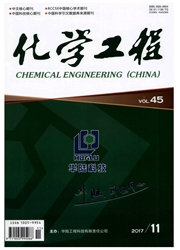

 中文摘要:
中文摘要:
近年来塔内流致振动诱发的塔板损坏的现象引起了人们的关注,塔板在连接处所发生的螺栓脱落乃至进一步的塔板坍塌对整个生产的效率有很大的影响。采用实验的方法研究了筛孔气速、液体流量、溢流堰高度等参数对塔板振动的影响。实验采用空气-水二相体系,在600mm有机玻璃塔内水和空气错向流动,接触状态为常压精馏中较为多见的混合泡沫态。实验利用动态应变仪对塔板中心附近径向应变进行测试,然后通过快速傅里叶变换分析其振动特性。结果表明:在混合泡沫态的操作工况下,塔板的振动频率值随筛孔气速的增加而变大,随溢流堰高度的增加而减小,而塔内液体流量对振动频率的影响较小;操作工况偏离正常范围时,可能导致塔板发生较大振动和塑性变形。实验结果为研究流致振动下塔板的破坏提供了一定的依据,为后续工业效率的提高和工作环境的改善奠定了基础。
 英文摘要:
英文摘要:
Several failures in industrial distillation and absorption columns are attributed to flow induced vibrations. It is important to have a basic understanding on the mechanism responsible for the flow induced vibrations. The strain measured shows that these vibrations may cause significant damage to the structures. The effect of superficial gas velocity ( based on the hole area), liquid flow and the height of weir on the vibration of a sieve tray column was experimentally studied using a th 600 mm plexiglass column with air-water system. Air and water were interacted by the way of cross flow, and the contacting regime was mixed-froth, which occurred most commonly in the atmospheric tower. Dynamic strain indicator was used to measure the radial strain of tray center, and fast Fourier Transform (FFT) algorithm was adopted to analyze the vibration characteristics. The results show that the frequency value of tray vibration increases with the rise of superficial gas velocity, while decreases with the rise of the height of weir, and the effect of liquid flow is insensitive. When the operating conditions deviate from the normal range, it may cause large vibration and plastic deformation.
 同期刊论文项目
同期刊论文项目
 同项目期刊论文
同项目期刊论文
 期刊信息
期刊信息
